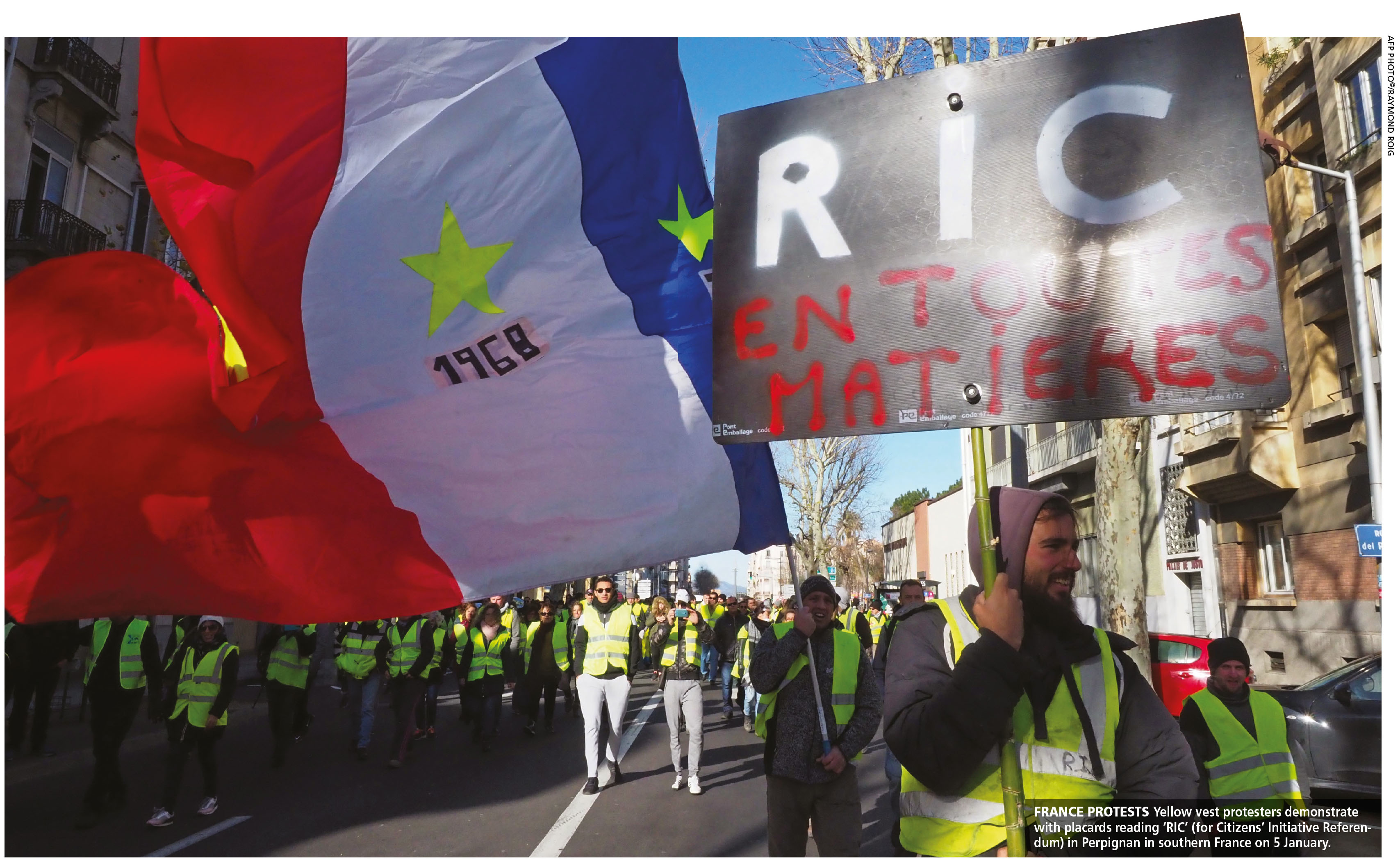PEOPLE POWER
THE YELLOW VEST MOVEMENT
Saro Thiruppathy writes on a lateral citizens’ movement protesting hardship by the French
The end of 2018 certainly wasn’t the best of times for French President Emmanuel Macron. It was more like the worst of times as the ‘yellow vest movement’ gained momentum in Paris and other parts of France.
Protests that have a visible leader are manageable since negotiation is possible but the yellow vest movement is leaderless and mobilises itself laterally via social media.
The protesters haven’t been welcoming of political parties since the protests addressed not only their original grievance but the very existence of the Fifth Republic.
HUMBLE ORIGINS In May last year, Priscillia Ludosky – a small-time entrepreneur living in the suburbs of Paris – launched an internet petition calling for a reduction of the price of fuel. She explained that taxes accounted for more than half the cost at the pump.
But it was only in October that Éric Drouet, a truck driver hailing from the same area as Ludosky, found and circulated it on Facebook.
The press then picked it up and the number of signatures, which had originally stood at 700, dramatically increased to 200,000. By December, the petition had more than 1.15 million signatures and that number continued to rise.
Drouet went further and mobilised a car rally protest in November to demand lower fuel prices. And many autonomous groups from the regions caught on to this through social media and decided to hold their own protests.
The movement drew its name from the high visibility yellow vests that are mandatory for drivers to carry in their vehicles. The protesters were mainly people who rely on their vehicles to get to and from work, and take their families on board since public transport in the suburbs isn’t great.
Small business entrepreneurs, independent contractors, farmers, home aides, nurses and truck drivers were among the numerous groups of people affected by high fuel prices. Their incomes were sufficient to get by but impending fuel taxation was the tipping point for the popularity of this movement.
Since the pressure group is nebulous, there’s no set agenda or discourse. Slowly but surely, more issues affecting the working people and retirees were annexed to the original grievance. The French people were protesting because they’re tired of hardship and want to see change.
MACRON CONCEDES Later in December as the pressure mounted, Macron conceded and told critics that the protesters were right about the fuel tax hikes. He even referred to it as a ‘citizens’ act’ and wrote on the Change.org website: “Your message – I heard it. I am responding to you directly; you are right.”
Macron added that while reducing fossil fuel usage was necessary to fight climate change, “it must not put the problems of the end of the world in opposition to the problems at the end of the month.”
He suspended the impending fuel tax and also proposed an increase in the minimum wage, tax cuts for low income workers, removal of a planned tax increase for a majority of pensioners and tax-free overtime payment for all workers in France. The bill for this is estimated to cost the state about 15 billion euros. And the National Assembly of France approved the proposals in December, pending only senate approval.
Meanwhile, the EU is growing anxious since spending by all Eurozone members must not exceed a three percent deficit. France’s original forecast was a 2.8 percent deficit, which will now run at 3.2 percent.
THE WAY FORWARD The Business Insider spoke with some protesters about the way forward. One interesting suggestion was the establishment of a Sixth Republic where the national assembly would truly represent the French people at the grassroots rather than only the elite.
Another was the establishment of direct democracy via the referendum system. Under this process, the référendum d’initiative citoyenne (RIC) or the ‘citizens’ initiative’ would use petitions to steer government agendas. The proposers suggest that if a petition reaches 700,000 signatures, it should be compulsory for the government to hold a referendum on its plans.
Under the current Fifth Republic introduced in 1958 by President Charles de Gaulle, too much power lies with the executive. The president can dissolve the national assembly at will.
And the prime minister – who is under the authority of the president – can be removed at will. Theoretically, the prime minister is answerable to parliament but in reality, it is the president who rules France.
Although it’s defined as a unitary semi-presidential constitutional republic, in practice governance is ‘hyper-presidential.’ The president enjoys full immunity and can only be removed in exceptional cases. So the Sixth Republic would need to ensure power devolution to the prime
minister and parliament, and restrictions placed on the powers of the executive.
Also of interest is the fact that many protesters preferred Macron to the alternative Marine Le Pen, and hoped to achieve their goals through him.
Meanwhile, the yellow vest movement is gaining popularity overseas. And since there’s no fixed agenda or leadership, it’s doubtful that this mechanism will disappear entirely because it represents the grassroots without political patronage.
And best of all, the movement is a phenomenon that can be picked up by the citizens of any country if they feel that their rights are being ignored or violated by the state.






Well said! We could do with a worldwide movement such as this. It is time the people take action.
Yes, the movement is becoming popular in more and more countries.
A great article.